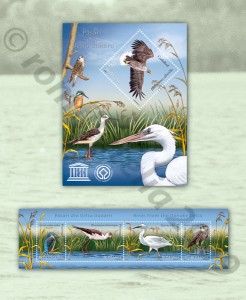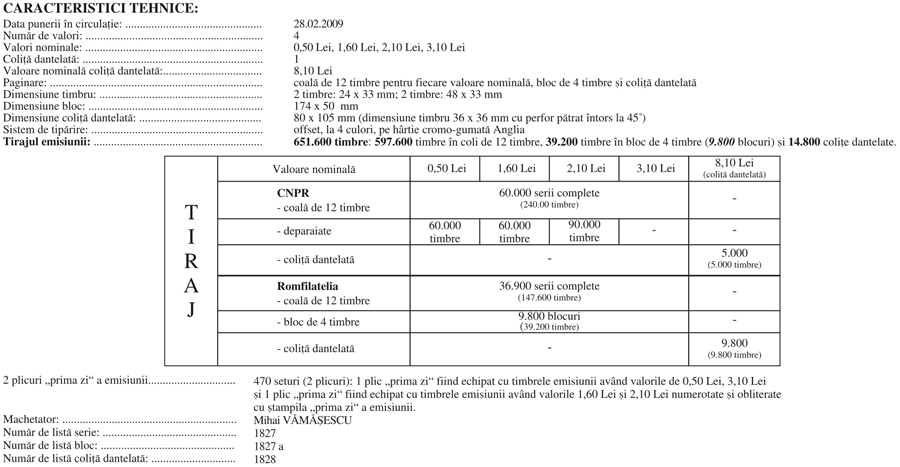 Every time a postage stamps issue with “birds” theme is released, for the collectors all over the world is a real philatelic feast.
Every time a postage stamps issue with “birds” theme is released, for the collectors all over the world is a real philatelic feast.
Coming to meet the wish of philatelists from our country and from abroad, Romfilatelia introduces into circulation the postage stamps issue “Birds from the Danube Delta”, having four stamps and a perforated souvenir sheet. Every time a postage stamps issue with “birds” theme is released, for the collectors all over the world is a real philatelic feast.
Coming to meet the wish of philatelists from our country and from abroad, Romfilatelia introduces into circulation the postage stamps issue “Birds from the Danube Delta”, having four stamps and a perforated souvenir sheet.
By editing this philatelic issue, Romfilatelia joins the UNESCO project for the Danube Delta protection, project sustained also by other nongovernmental organizations from our country and from Europe, which fight to protect and to save this invaluable natural habitat. The Danube Delta lodges over 3,400 species of vertebrate and invertebrate animals, many national, European but also world unique species living here. The ornitho-fauna from the Danube Delta totals more than 300 species, from which around 70 species are extra European ones.
Birds (the Aves Class) represent a group of four-footed vertebrates, which developed from reptiles, nevertheless preserving certain features of these ones. They are the first vertebrates which can maintain a constant body temperature. The most obvious feature of the birds is the adaptability to flight. Due to this fact, the birds are Globe´s most spread species, passing over geographical obstacles, travelling long distances, conquering even the regions with severe climate. Many species of birds migrate during winter and summer.
The Aves Class includes approximately 8,650 species grouped in 28 orders.
The postage stamps of the philatelic issue illustrate the following birds from the Danube Delta, which are legally protected: Common Kingfisher, Black-winged Stilt, Great Egret, Danubian Falcon and White-tailed Eagle.
The Common Kingfisher (Alcedo atthis athis) – illustrated on the stamp with the face value of RON 0.50. The Common Kingfisher is just 16-18 cm long and it has a vivid color, so that it looks like a jewel, blue-green on upperparts, red-orange on underbelly and white on gizzard and the scruff side parts. It nestles on sweet water banks. Twice a year (in April and in June) it lays 6-7 eggs which it batches around 20 days. He feeds with small fishes and his flight is fast as an arrow. It can be seen on the flowing waters bank and is very widespread in the Danube Delta.
The Black-winged Stilt (Himantopus himantopus) – illustrated on the stamp with the face value of RON 1.60. The Black-winged Stilt can be easily recognized by its very long dark red or pink legs. Its general plumage is white and only the wings are seen black when it flies. Its beak is long, black, flat and thin. It is a summer guest in the Danube Delta, where it nestles in small colonies, formed in salting areas.
The Great Egret (Egretta alba) – illustrated on the stamp with the face value of RON 2.10.
It is also called the Great White Heron. It is the rarest heron from the Romanian fauna and it was declared nature´s monument. It is a member of the Ciconiiformes order, Ardeidae (herons) family. It is 90 cm long and can be seen in Europe, Africa, Asia and Australia. In Romania the bird is a summer guest and can be seen mostly in the Danube Delta.
The Danubian Falcon (Falco cherrug) – illustrated on the stamp with the face value of RON 3.10. The Danubian Falcon is around 50 cm long and his wingspan is over 120 cm. It is lightish brown on upperparts and white on the head. It lives in steppe areas. It nestles in trees on water banks. In the Danube Delta it uses the White-tailed Eagle´s nests. It usually feeds with ground squirrels and birds.
The White-tailed Eagle (Haliaeetus albicilla) – illustrated on the souvenir sheet with the face value of RON 8.10. The White-tailed Eagle is 77-92 cm long and its wingspan has between 190 and 240 cm. It prefers isolated areas, wet or flooded zones, like the deltas. It is one of the biggest birds of prey from our country, with very wide spanned wings and strong unfolded at the cap. The adults are brown and have white tail, chisel-shaped. It feeds with slow flying birds, fish, carcasses and sometimes with reptiles and rodents. It nestles in trees. Usually it has one or two chicks per year.
We bring here special thanks to UNESCO Romania for the partnership in promoting the values of the World Heritage.
Issue date: 2009-02-28



